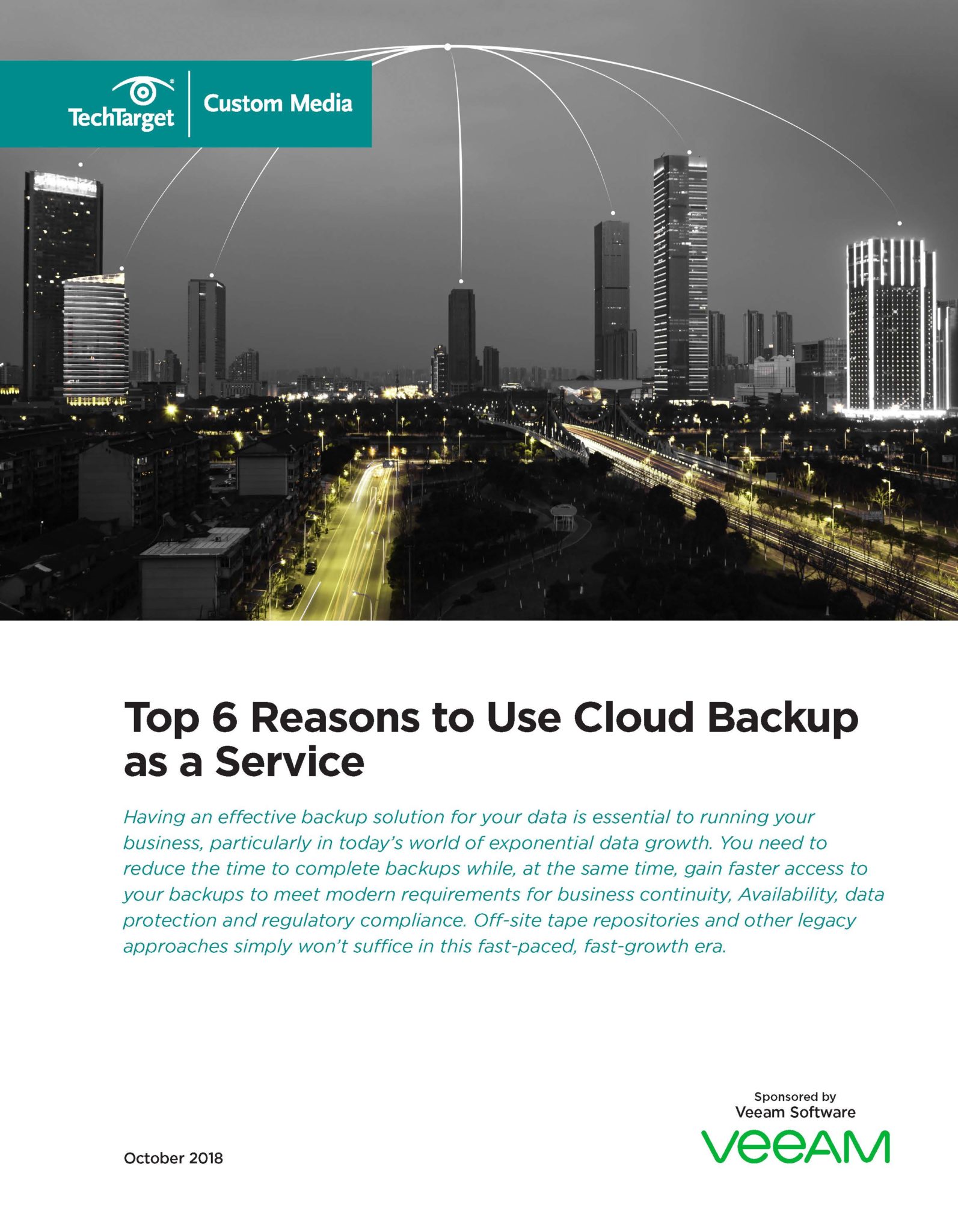
However, while a backup is absolutely essential and strategic in supporting the overall availability of your business, it is not where you want to expend a major upfront capital investment, and subsequently spend even more money just to keep up with data growth, maintenance, management, and equipment upgrades. It is also not where you want to devote precious IT personnel resources. Let’s talk about cloud backup as service.
There has to be a better way, and thanks to the cloud, there is. It is cloud backup as a service, and it is proving to be a revelation for companies of all sizes—especially those with limited IT personnel and capital resources. It enables you to lower costs, reduce the workload on IT, improve security and compliance, leverage the skills of an experienced service provider, and move to an Opex pricing model.
Given these benefits, it is no wonder that the backup-as-a-service market is growing strongly, at a compound annual rate of 27.04%. No matter the size of your company, it is time to find out what cloud backup as a service can do for your organization. Here are six of the top reasons why every organization should be evaluating cloud backup as a service, for now, and into the future.
No. 1: Maximize your IT resources
Most organizations today have limited IT resources, particularly in personnel. Just about every organization has more strategic opportunities than it can handle, ranging from day-to-day activities such as empowering mobile workers to big-picture initiatives like digital transformation. Why spend your limited resources on a “keep the lights” on function like backup, when the cloud makes it simple and turnkey? Using a modern cloud solution, you can easily move backups off-site to a service provider while maintaining complete visibility and control, end-to-end encryption and quick access to your backups whenever you need them.
No. 2: Reduce total cost of ownership
It’s not just personnel resources that are costly in trying to do backup yourself: You must make an upfront investment in equipment that can be expensive—and continue to outlay Capex for upgrades, expansions, and eventual replacement. This is an old model that doesn’t work in the cloud era. Not only will your organization have to invest in storage, but it will also have to invest in virtualization—otherwise the expense can be prohibitive. With cloud backup as a service, you can take advantage of the cloud’s elasticity to pay for only what you need, when you need it. No need to overprovision resources. Performance is also a factor because disk or tape is likely going to be slower than the cloud, and that will come at a higher cost.
No. 3: Move to an Opex purchasing model
Today’s reality is that business leaders, whether in the executive suite or running a line of business, strongly favor an Opex model for IT spending versus the traditional Capex model. It gives organizations more flexibility, requires less upfront investment, is much easier to manage, doesn’t require overprovisioning and is much easier to plan and budget. IT overall is moving to a service-oriented model, and backup is a natural fit. In fact, because cloud backup as a service is simple to deploy, many IT teams are using it as an example to show management just how effective cloud can be in reducing TCO and shifting to an Opex model. Think of it as a gateway to the cloud for other applications and workloads.
No. 4: Easily achieve best practices
In the world of backup, it is widely accepted that to achieve best practices, you must adhere to the “3-2-1 rule,” which is:
3 – Maintain at least three copies of your data.
2 – Store data on at least two different types of storage media.
1 – Keep one copy of the backups in an off-site location.
For many companies, getting backups off site can be a challenge because of limited bandwidth, expanding data volumes and lack of resources to build or maintain a true offsite backup repository. With the right cloud backup-as-a-service solution, however, you can easily move back up to a cloud service provider with the necessary bandwidth at no additional cost.
No. 5: Leverage the knowledge and experience of a service provider
As organizations move more workloads and applications to the cloud, they are finding huge benefits in working with an experienced cloud service provider. Cloud backup is simple on the one hand but complex on the other—largely because there are a range of options whose value differs from one organization to another, based on particular needs. Your organization may need a simple data repository, or it may need to have it managed. You may need additional features for security, compliance or sovereignty, depending on where and how you do business. You may choose to use a solution that offers replication in addition to backup so you can have added capabilities for disaster recovery. Working with a cloud-managed service provider, you can do a hands-on needs assessment and deploy a strategy that is specific to your particular organization.
No. 6: Simplify, accelerate and improve disaster recovery
By moving to cloud backup as a service, you will immediately improve your ability to respond to a disaster or any other event that impacts Availability. You will be able to achieve 3-2-1 best practices in backup, which means you will have your business-critical data at an off-site location in the cloud. And because it is in the cloud, you can access and recover it quickly, as opposed to, for example, having backups on tapes sitting somewhere in an underground storage facility. If you really want to simplify, accelerate and reduce the costs of disaster recovery, you can choose a solution and service provider that also offers cloud-based replication. This will give you efficient and affordable disaster recovery, with recovery time objectives (RTOs) and recovery point objectives (RPOs) of less than 15 minutes for all applications — and you won’t have to invest in a second site.
What to look for in a solution
In evaluating what to look for in a cloud backup-as-a-recovery solution, there are several critical characteristics to consider, including:
- Industry-leading backup software that has been designed to take advantage of today’s highly virtualized Look for a solution that has modern features such as end-to-end encryption and simple, high-bandwidth connectivity to get your backups off site and into the cloud service provider’s backup repository.
- A broad ecosystem of cloud partners, including all of the major public cloud providers — such as Amazon Web Services, Microsoft Azure, IBM Cloud, Google Cloud, Alibaba Cloud, and Oracle Cloud — as well as a wide range of managed cloud service providers that can offer you guidance and
- Multiple features and functions to fit the needs of your organization, whether you are looking for a simple repository as a first-time cloud user or you are trying to Maximize Availability and data protection with added-value capabilities, such as WAN acceleration or full-site failover to a remote DR
Taking the next step
When it comes to meeting the needs of today’s businesses and achieving the six critical benefits cited above, the No. 1 option for any size organization is to use cloud solutions from Veeam in conjunction with a cloud-managed service provider. This combination delivers:
- Hosted off-site backups
- Complete visibility and control
- A modern backup architecture
- End-to-end encryption
- Built-in WAN acceleration technology
- A broad ecosystem of cloud service providers, including all of the leading public cloud options
Is your organization ready to take its first step or the next step on the cloud journey by leveraging cloud backup as a service?
Please visit IGTech365 at
https://igtech365.com/it-consulting-near-me/
to see how we can help.


Recent Comments